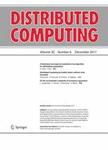版权所有:内蒙古大学图书馆 技术提供:维普资讯• 智图
内蒙古自治区呼和浩特市赛罕区大学西街235号 邮编: 010021

作者机构:Vienna Univ Technol Embedded Comp Syst Grp E182 2 A-1040 Vienna Austria Ecole Polytech Lab Informat LIX F-91128 Palaiseau France
出 版 物:《DISTRIBUTED COMPUTING》 (分布式计算)
年 卷 期:2009年第22卷第1期
页 面:29-47页
核心收录:
学科分类:08[工学] 0812[工学-计算机科学与技术(可授工学、理学学位)]
主 题:Computing models Fault-tolerant distributed algorithms Partially synchronous systems Clocks and time
摘 要:We present a novel partially synchronous system model, which augments the asynchronous model by a (possibly unknown) bound I similar to on the ratio of longest and shortest end-to-end delays of messages simultaneously in transit. An upper bound on those delays need not exist, however, and even I similar to may hold only after some unknown global stabilization time. I similar to-algorithms are fully message-driven and do not have access to bounded drift local clocks, which makes them particularly suitable for VLSI Systems-on-Chip, for example. In this model, we provide a simulation of (eventually achieved) lock-step rounds, which even works in the presence of Byzantine failures. It follows that most problems in distributed computing have a solution in our model: Using the basic consensus algorithm for partially synchronous systems by Dwork et al. (J ACM 35(2):288-323, 1988), for example, Byzantine consensus can be solved. We also introduce a timing transformation technique that facilitates simple correctness proofs and performance analyses of I similar to-algorithms, and provide a detailed relation of the I similar to-Model to other partially synchronous system models.